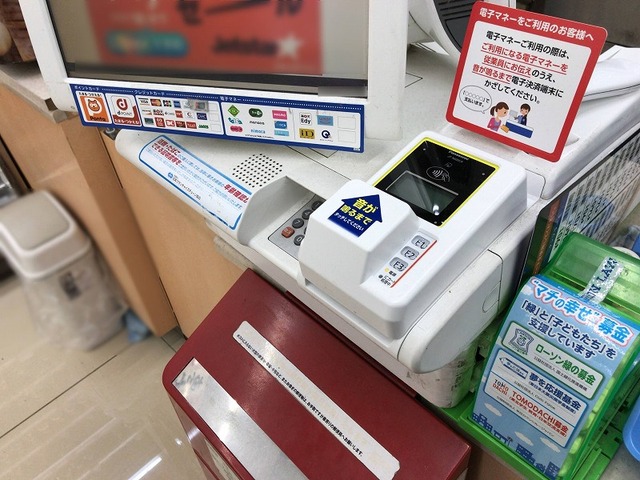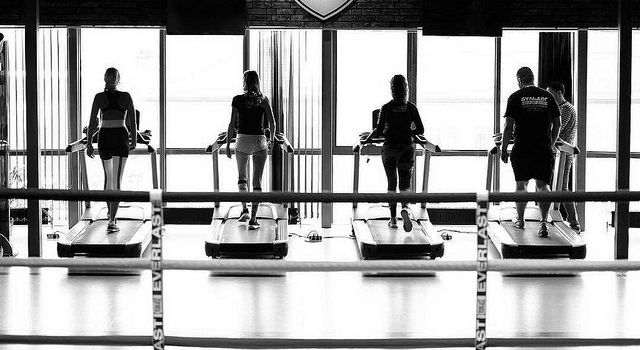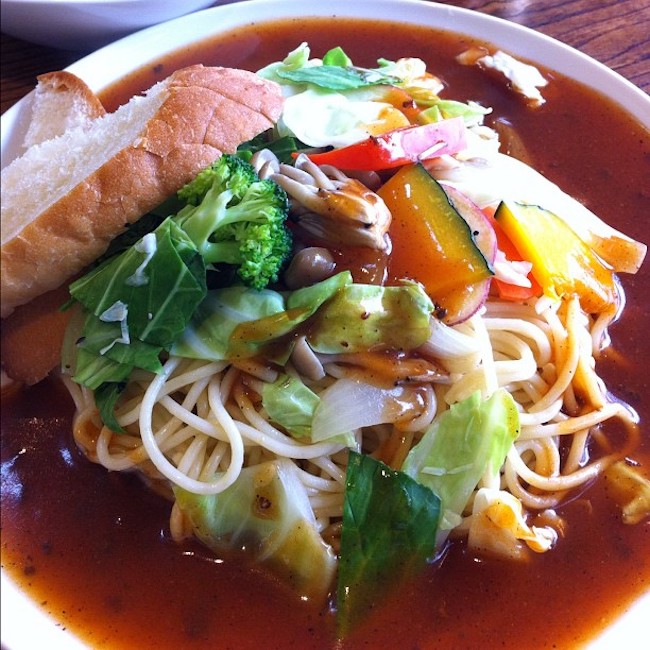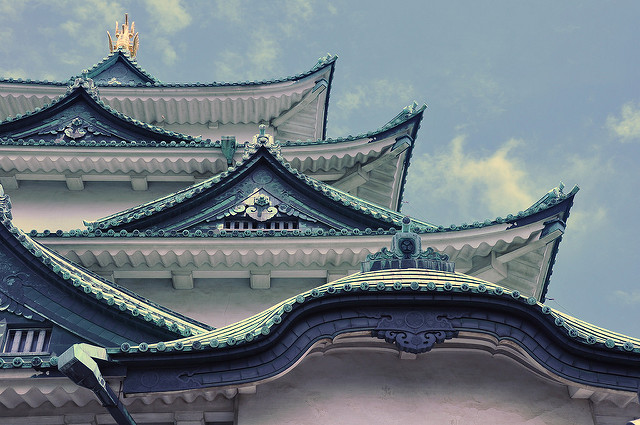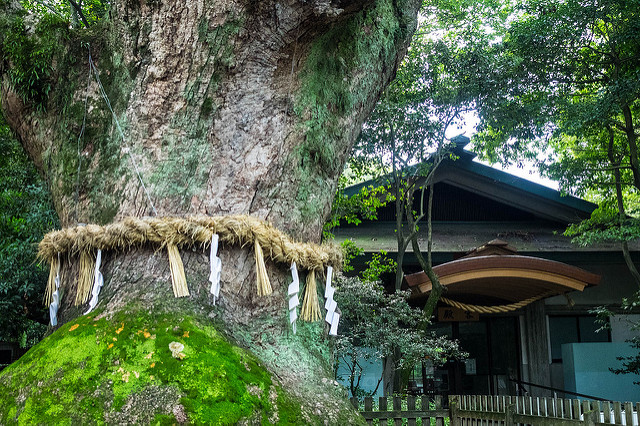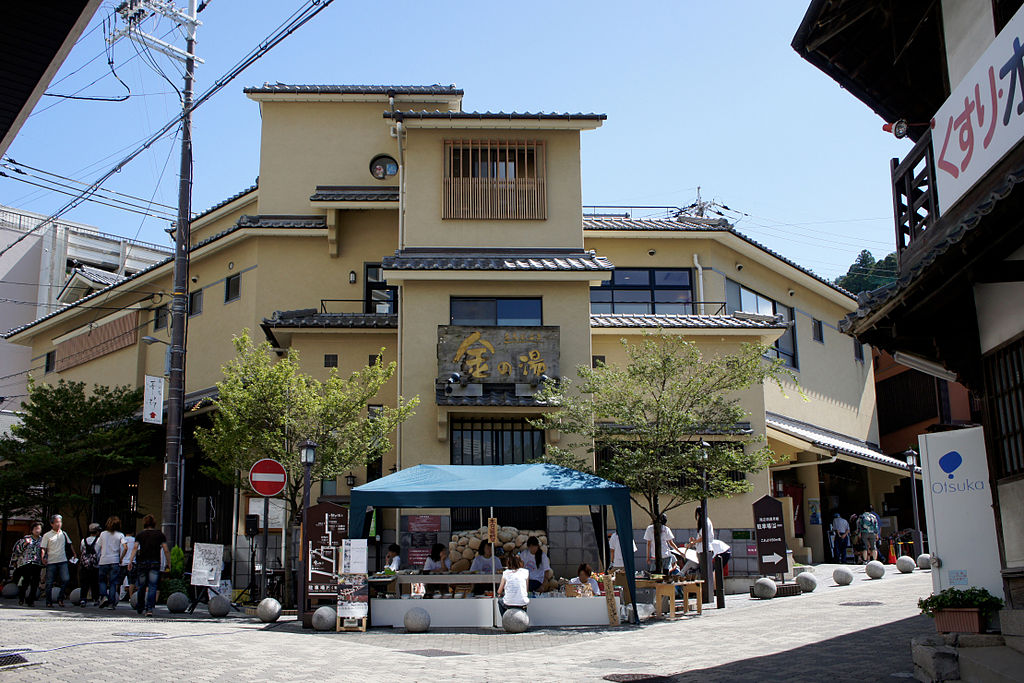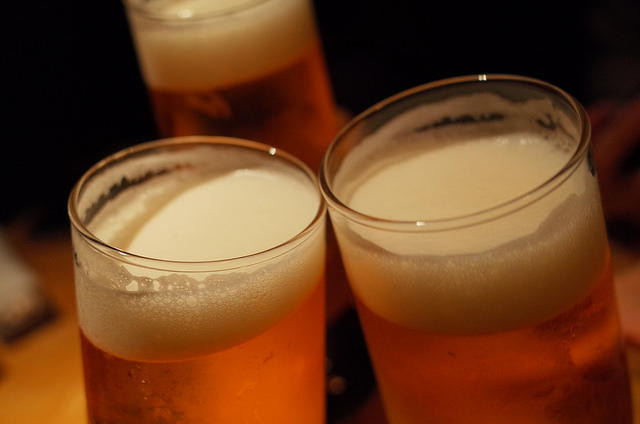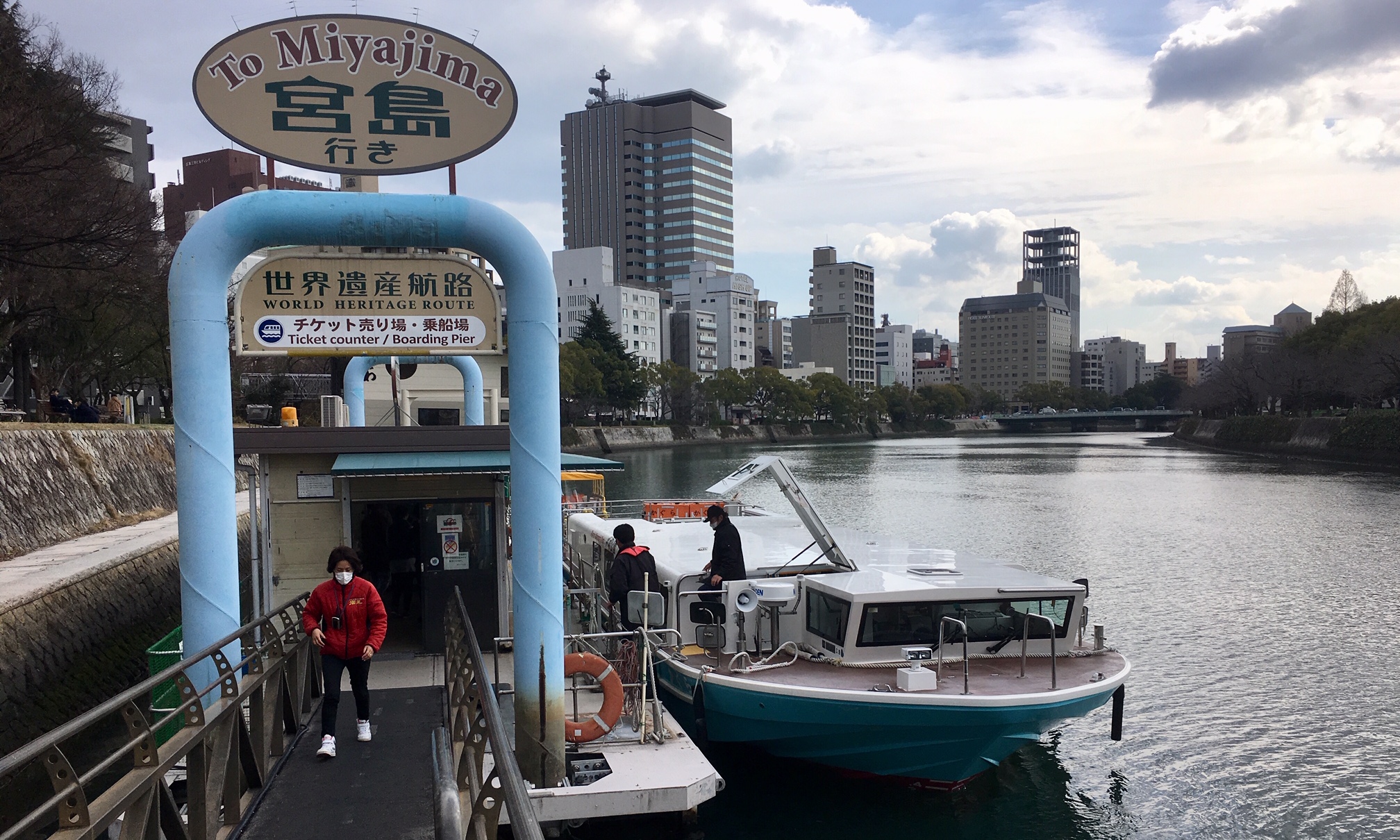Feb 28, 2019
Going cashless in Japan
Almost 20 years ago in order to prepare for my first trip to Japan I was advised by my travel agent as well as my cousin who resided here already that I needed to bring plenty of cash and traveler’s cheques (remember those?) with me because Japan doesn’t do credit cards or ATMs for foreigners. But in 2019, not only are there cash machines in every convenience store, but many stores and restaurants take credit and debit cards as payment and e-money like transport passes and Apple Pay are also becoming almost universal as well. Plus now there seems to be a “_ Pay” barcode mobile payment scheme popping up all over the place in Japan, emulating how transactions work in places like China.
This is all because the perfect storm of Rugby World Cup 2019 and Tokyo Olympics 2020 that will bring the world to our neck of the woods expecting their credit cards to work seamlessly… But the major reason is due to the national consumption tax levied on almost all purchases set to raise from 8 to 10% in October. In order to combat some of the shock it will place on many households, the government has proposed a rebating system that will automatically roll back the tax rate to between 5 to 8% depending on the product being sold and the amount of goods purchased in a set period by the consumer. In order to track these purchases, one will need to use an electronic payment scheme; a credit or debit card, e-money like Suica or Edy, or barcode payment app like LINE Pay or R Pay to even Japan Post’s Yu Pay. This scheme applies to foreign residents who hold long term visas 1 year and longer, but not short-term visa holders and visitors.
In an effort to get a feel of this new “cashless society”, I went about my daily routine for a week without using cash as much as possible. This includes my commute from Setagaya Ward to Kokubunji in Tokyo for work, as well as leisure time with my partner, 3 kids and a dog.
A Week of Cashless Life
Day 1: Commuting is easy since I use Mobile Suica and Apple Pay. In fact, I keep two virtual Suica cards: One on my Apple Watch for actually using public transport (this way I don’t need to even dig my phone out of my bag or pocket) and one on my iPhone (used for buying things at the store or vending machines.) Stopped at McDonald’s by work for coffee and a McMuffin and paid with Suica there too. For lunch I went to Lawson and used LINE Pay’s QR code because they’re offering cash back. During the PM commute, I stopped at the grocery store and used my Seven Bank debit card, as usual.
Day 2 Same as above with commuting. Went to 7-Eleven for a lunch bento and used my Seven Bank Card’s Nanaco e-money function there because there was a 30% points back deal on my bento and a reduced price for the juice I bought. I went to Lawson 100 (a chain of ¥100 stores operated by the convenience store chain) and picked up some knick-knacks. Used Line Pay Barcode there.
Day 3 I needed to recharge my Suica train pass and used the Seven Bank ATM to withdraw cash from the bank then load it onto the virtual Suica right at the machine. I could’ve just used the app to do this with a few taps but I wanted to see how the new ATMs deal with Mobile Suica. I also used Apple Pay at the vending machine at my job to buy a canned coffee.
Day 4 Was a carbon copy of the last few days mostly, but I also needed to get a new cable for my phone charger. Using Line Pay at Bic Camera, I took care of that errand.
 Day 5 Was the same as the above days at work, but afterwards I was invited to drink with a few buddies in Shinjuku. We wound up in Yama-chan. I told my friends about this experiment and when the bill came, I paid using my debit card and they gave me their portions in cash. This exposes the first crack in the system; had we been in my native America, we could split the check at the table and pay separately. Also it’s trivial to use something like Venmo or CashApp to send and receive funds from friends. LINE has this ability but depends on everyone being a LINE Pay user first.
Day 5 Was the same as the above days at work, but afterwards I was invited to drink with a few buddies in Shinjuku. We wound up in Yama-chan. I told my friends about this experiment and when the bill came, I paid using my debit card and they gave me their portions in cash. This exposes the first crack in the system; had we been in my native America, we could split the check at the table and pay separately. Also it’s trivial to use something like Venmo or CashApp to send and receive funds from friends. LINE has this ability but depends on everyone being a LINE Pay user first.
Days 6 & 7 The weekend saw me spending time with my family at home mostly but we decided to go to the theater to see a movie. Toho Cinema’s app allows the use of Apple Pay to purchase tickets so I used that. The kids wanted Saizeria and that’s when I ran into another roadblock. The location near us is cash-only, so out came the yens. The next day went smoothly with gas station, DIY shop and Costco purchases all being done with cards. However my lunchtime plan hit the cash-only wall again at the local ramen shop and the discount grocery store, Gyomu Super.
In conclusion
You can get by day-to-day without cash in most cases in Tokyo. Most of us here in the Metropolis have access to large chain stores and restaurants. Where it breaks down is the mom & pop shops and places that cater to a local crowd that tends to make small purchases in cash. This will all need to change in a hurry if the government wants to enact the tax hike and rebate system by autumn. Of course we’ll be following up on this as it unfolds here, so stay tuned for future updates.
— By Jason L. Gatewood
Images: “Cash Register” (CC BY-NC 2.0) by Jason L. Gatewood
20000 yen” (CC BY-NC 2.0) by mrjoro
Feb 28, 2019
How to use Public Sports Facilities in Tokyo
Staying in shape in a big city like Tokyo can be a chore sometimes; I myself am a big fan of running and biking outdoors, and sometimes it seems cars and bad traffic along with the sometimes extreme weather can have me sidelined for days, sometimes weeks without getting my weekly workouts in. Fortunately, I live near one of the cheapest solutions to this problem, and it’s very likely you do too: The Public Gymnasium.
 Called anything from “Sports Center(スポーツセンター)” to flat out “Taiikukan (体育館, literally “fitness building”), these community operated gymnasiums have almost the same complement of equipment and amenities as their privately run counterparts but the prices are vastly inexpensive in comparison. While most of the gym chains will charge a ¥30,000 sign-up fee and run around ¥10,000+ per month, one can usually join a community gym for less than ¥2000 per month without a signup fee and sometimes less if you happen to be a resident of the ward or city where it is located. Most gyms have a training room with a full complement of weights, resistance training machines, treadmills, and stationary bikes. Many offer martial arts dōjōs, basketball and volleyball courts, and even pools and saunas. Usually, they will have training classes and clubs like aerobics, cross-training, and even indoor climbing and archery.
Called anything from “Sports Center(スポーツセンター)” to flat out “Taiikukan (体育館, literally “fitness building”), these community operated gymnasiums have almost the same complement of equipment and amenities as their privately run counterparts but the prices are vastly inexpensive in comparison. While most of the gym chains will charge a ¥30,000 sign-up fee and run around ¥10,000+ per month, one can usually join a community gym for less than ¥2000 per month without a signup fee and sometimes less if you happen to be a resident of the ward or city where it is located. Most gyms have a training room with a full complement of weights, resistance training machines, treadmills, and stationary bikes. Many offer martial arts dōjōs, basketball and volleyball courts, and even pools and saunas. Usually, they will have training classes and clubs like aerobics, cross-training, and even indoor climbing and archery.
Here is a list of a few public gyms around central Tokyo:
3-5-1 Okubo, Shinjuku, Tokyo, 169-0072
1-40-18 Nishihara, Shibuya, Tokyo 151-0066
1 Komazawa koen,Setagaya, Tokyo
3−16-1 Shibaura, Minato, Tokyo
Toshima Ward Ikebukuro Sports Center
2-5-1 Kamiikebukuro, Toshima, Tokyo
— By Jason L. Gatewood
Images:
Feb 27, 2019
Ankake Spaghetti, Nagoya’s Italian Treat
From soba to ramen, udon to somen, hiyamugi to shirataki, Japanese cuisine is blessed with a wide variety of of noodle kinds. But if that wasn’t enough, they had to take Italy’s greatest export and make it their own in the form of ankake spaghetti.
Like miso katsu, tebasaki and doteni, ankake spaghetti (sometimes called ankake pasta) continues the long tradition of Nagoyan cuisine bucking the national trend for delicate flavors, and instead going for strong tastes and eye-catching colors in its ‘soul food’.
But if you are expecting something similar as to what you would find in an Italian restaurant, you may be in for a surprise.
What is Ankake Spaghetti?
Although ankake spaghetti obviously has its origins in the Italian dish, it was created with the Japanese palette in mind, with attempts to adapt a meat ragu or Bolognese sauce to make something more appropriate for Nagoya locals. While the sauce is often tomato based, it is instead rich, spicy and sticky as might be served up in Chinese restaurants. In addition, the thick spaghetti noodles are pan-fried and often have a texture similar to yaki-udon.
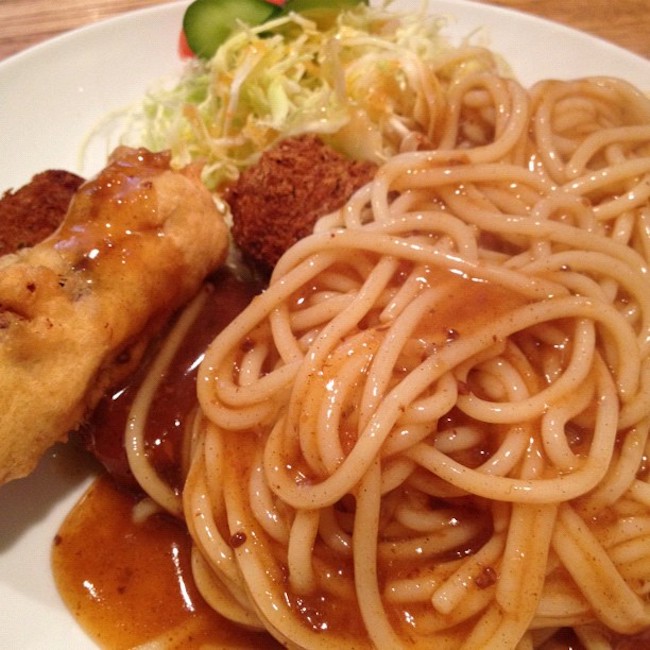
There are various toppings for ankake spaghetti, with the most popular being Weiner sausages, onions, and green peppers, making it a bright dish that looks like it could have been created for easily distracted children.
You can also get ankake spaghetti that is topped with, amongst other things, deep-fried prawn (ebi furai), bacon, cutlets served in a piccata style, hard boiled eggs or just mixed vegetables. Dishes that are meat based are called Milanese and those that are solely vegetables are country (or ‘miraneze’ and ‘kantori’ respectively) with combination dishes being ‘mira-kan’, a portmanteau of the two styles.
Where to Find Ankake Spaghetti
Although ankake pasta’s popularity has spread throughout Japan, with restaurants popping up all around the country, the best – and original – is still to be found in Nagoya.
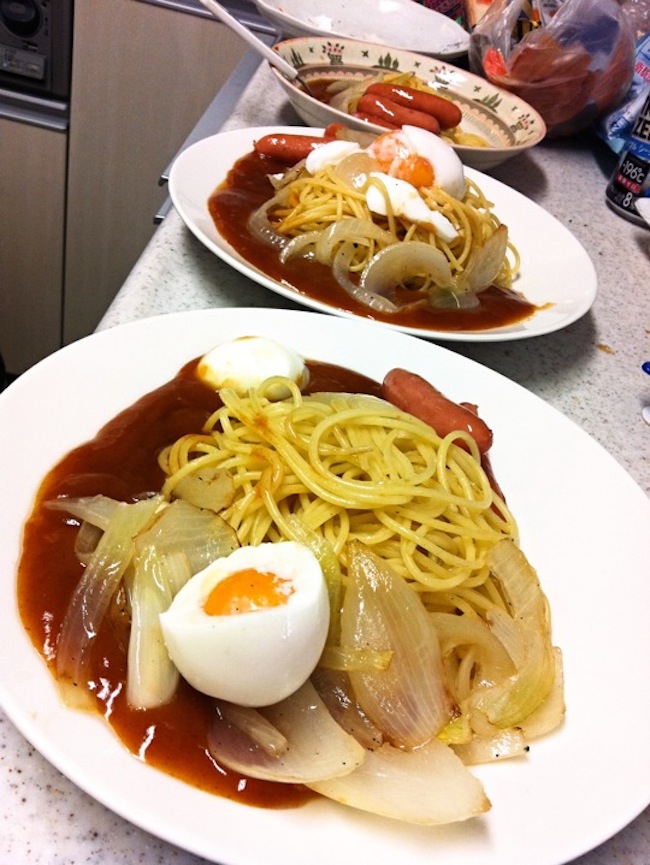
Spaghetti House Yokoi
Spaghetti House Yokoi is known for its particularly thick noodles and claims to be the first to serve the dish. There are a number of branches in the city, but the original restaurant is in Sakae.
Where: 1F Asahi building 3-14-25 Nishiki, Naka-ku (map)
Website: www.yokoi-anspa.jp
Spaghetti House Sole
Established in 1961 and another restaurant that it is thought could be the true originator of the ankake dish, Spaghetti House Sole is a true piece of Nagoyan culinary history.
Where: 103 Aishin Plaza Building 4-9-10 Sakae, Naka-ku (map)
Website: www.so-le.co.jp
Spaghetti House Ciao
Spaghetti House Ciao is one of the most popular ankake restaurant in Nagoya, and has been around since before the term ‘ankake spaghetti’ was even coined.
Where: 1F Dai 5 Horiuchi Building 4-5-19 meieki, Nakamura-ku (map)
Website: www.ciao-morita.co.jp
Mark Guthrie
Image: by naka hide via flickr.com [CC BY-SA 2.0] – Modified
Image: by lefty1007 via flickr.com [CC BY-SA 2.0] – Modified
Image: by lefty1007 via flickr.com [CC BY-SA 2.0] – Modified
Feb 27, 2019
Do You Know Nags? Nagoya’s Hidden Gems – Part 3
Whether you have been here for a few weeks or know the city like the back of your hand, Nagoya is a city that is full of surprises. New restaurants and bars pop up all the time, and you can be strolling down a familiar street and suddenly notice a temple you’ve never seen before.
We all have our favorites, our haunts, our places of sanctuary. In this JIS series, Nagoya residents share their recommendations so you can get to know this amazing, beautiful, eclectic city as well as they do.
Who? Madoka Suzuki
Recommendation? Osteria del Cuore
Madoka is Nagoya born and bred, and there is nothing she likes more than checking out different restaurants around the city. But despite the variety on offer, she always finds herself coming back to Osteria del Cuore in Yagoto.
“It’s in the middle of a quiet residential area, so it’s not like some fancy city center restaurant, it’s got a real ‘hole-in-the-wall feeling to it. It’s small, with just one chef, but he does great home-style Italian cuisine,” Madoka explains.

“I go there with my family for dinner often, but my favorite time is on a weekend after going to the market at Kosho-ji temple, taking the pleasant fifteen minute walk, and going to the restaurant for lunch. It’s also got a nice little balcony, so on warm days you can sit outside with a glass of wine and enjoy the breeze.”
Where: 2 Chome-2404 Omoteyama, Tenpaku Ward (map)
Website: cuore.nagoya
Who? Hunter Smith
Recommendation? Nagoya Blue Note Jazz Club
Hunter, originally from Virginia, USA, is about to celebrate his seven year Japaniversary, living the whole time just outside of Nagoya.
He is something of a music afficianado, and when he’s not in a craft beer or coffee place, he’s often perusing one of Nagoya’s many record shops. However, he recently found Blue Note Jazz Club.
“Blue Note has got the same atmosphere and intimate vibe as its NYC origin, which is good because that place has set a gold standard of sorts for jazz venues. Beautiful lighting and sound, as soon as you sit down, you know it’s going to be an enjoyable time, It helps that the staff was bustling when I was there and the whiskey was top shelf,” Hunter gushed.

“It’s tucked deep into the underground of Sakae (I honestly think it’s got to be four levels below the entrance), and because of that it almost gives a kind of secret speakeasy feel. It was packed, so I sat beside a collection of people at a table and chatted before the show, which was great and not a super common experience in Japan.
“It seemed to be a real mix of crowds, lots of tables for dining, and back seating for drinks and more private conversations. There’s only the one here in Nagoya and the one in Tokyo (Osaka changed names, I believe), so it’s a real find.”
Where: Naka Ward, Nishiki, 3 Chome-22-20 Daitec Sakae Building (map)
Website: nagoya-bluenote.com
Who? Manami Farrow
Recommendation? Chiyobo Inari Shrine
Manami is another who has lived in Nagoya her whole life, and as such she knows some great spots, but when it comes to recommendations she likes to go a little further afield.
“Chiyobo Inari Shrine is about an hour out of Nagoya, but it is well worth the drive. It is very much a hidden gem, and I am sure that it would be very interesting for foreigners.”
Loved by the locals who call it ‘Ochobo-san,’ the shrine is home to the Inari Okami, the god of agriculture, and many visitors come to pray for prosperity, but that is not why Manami recommends it so highly.
“I love Ochobo-san for the night market. In Japan, these are not regular occurrences except for on New Year, but here they have one on the last day of every month. It is always lively and fun, and they have amazing kushi katsu, and Nagoya’s famous doteni. I love the style of standing in front of a boiling pot of miso and you are served while they are fresh and hot. Though be warned, you may need to wear miso stain-friendly clothes and shoes!”
Where: Gifu Prefecture, Kaizu, Hirata-chō Misato 1980 (map)
Website: www.chiyohoinari.or.jp
Who? Jay Drew
Recommendation? Tomiyama
Jay has lived in and around Aichi for around seven years, with the last three in central Nagoya. Being an outgoing and friendly sort of chap, he likes to go to restaurants where he can really get to know the people there, whether it be the proprietor or the customers, and he finds that at Tomiyama.

“The restaurant is just below Freebell Mansions [a.k.a. ‘gaijin Towers], so there is always a lively combination of both Japanese and foreign customers.
“Fuji san, the owner, is a great guy and always happy to see us. The menu is pretty extensive, but my favorites are the curry udon and the awesome fried chicken omrice curry. It’s got to be tasted to be believed!”
Where: 2-10 Ushijimacho, Nagoya (map)
Website: r.gnavi.co.jp (Third party website)
Mark Guthrie
Image: by Yuya Tamai via flickr.com [CC BY-SA 2.0] – Modified
Image: via https://cuore.nagoya/concept/
Image: by via flickr.com [CC BY-SA 2.0] – Modified
Image: by Mark Guthrie (Own work)
Feb 26, 2019
Must See Shrines and Temples of Nagoya
Japan is served by two predominant religions: Shinto and Buddhism. Shinto is a form of ancestor worship and is the traditional religion of Japan – though it was codified in the eighth century it had been around for many centuries before with evidence that it was around during the pre-historical Jōmon period – with many Gods, or ‘kami’, housed in shrines around the country.
Buddhism came to Japan around the 6th century (though it is possible that it had been introduced some two hundred years before) and grew side by side with Shintoism. Today many Japanese worship both religions, with it being said that Japanese are born in Shintoism, and die in Buddhism, with the latter having the advantage of a belief in reincarnation over the former. (Recently this phrase has been modified to add that Japanese are also married in Christianity, reflecting the propensity for young people to wed in Christian-style ‘churches’.)
For many centuries, Shinto shrines and Buddhist temples co-existed on the same grounds, one standing shoulder-to-shoulder with the other. However, during the Meiji era (1968-1912), a period of great upheaval in Japanese society as the country transformed from samurai rule to become an industrial super power, a decree was passed that these houses of worship must become either one or the other, leading to many shrines and temples to be destroyed.
However, there are still many fantastic shrines and temples to be found within the city of Nagoya. Here are a few of our favorites.
Atsuta Jingu
Atsuta Jingu ranks in importance second only to the Great Shrine of Ise in Mie (the center of the Shinto religion in Japan) and draws over 9 million visitors a year to its gates. The shrine, located in Atsuta Ward of Nagoya City, dates back nearly 2,000 years, and is dedicated to the “Five Great Gods of Atsuta”, who are connected with the sacred sword Kusanagi no Tsurugi, or “The Grass Cutting Sword”.
The sword is one of the Three Imperial Regalia of Japan. According to the 8th Century compiled kojiki, Chronicle of old things, the oldest extant chronicle of Japan, the god, Susanoo found the sword in the tail of an eight headed dragon he had slain. The sword was later presented to the goddess Amaterasu, and later presented to the warrior Yamato Takeru, who used it’s magical powers to cut his way out of a grass fire started by a treacherous enemy warlord, hence it’s moniker.
- Where: Atsuta Ward, Jingu, 1 Chome−1−1 (map)
- Website: atsutajingu.or.jp
Osu Kannon
When getting off at the Ōsu Kannon subway station on the Tsuramai line, it is difficult to miss the large Buddhist temple from which the station takes its name. The original temple was built in 1333, though to save it from regular flooding the shogun Tokugawa Ieyasu had it moved from where it had stood in Ōsu-gō, Nagaoka village, (now known as Hashima in Gifu Prefecture) to its position today. Unfortunately this did not protect it from the devastation it suffered following a large fire in the 1820s, and the attacks on Nagoya during World War 2. It was rebuilt in the 1970s, which is what we can see today, but this does not detract anything from its beauty.
Fortunately the wooden statue carved in the eighth century by the famous monk Kōbō- Daishi of the temple’s deity the bodhisattva Avalokiteshvara, Kannon in Japanese, survived these disasters and looks over the temple and its worshipers to this day. Below the building is a library containing around 15,000 classic items of literature, including the oldest manuscript of the aforementioned Kojiki, the first book on Japanese mythology.
- Where: Naka Ward, Osu, 2 Chome−21−47 (map)
- Website: osu-kannon.jp
Nittaiji Temple
The name literally means Japan-Thai temple and was built to represent the harmony between the two nations. It was established in 1904 to enshrine Buddha’s ashes and a gilt bronze gifted by the king of Thailand in 1900, and is the only temple in Japan that does not represent a single sect of Buddhism as it was built following the agreement of the representatives of all the Buddhist sects.
The holy remains are enshrined in a 15m Gandhara style tower, a Hoanto, built in 1918. Since then the temple grounds have grown to include a large Dharma hall as well as a five story pagoda. You will also find a street fair in the area on the 21st of each month.
- Where: Chikusa Ward, Shiroyamashinmachi, 1 Chome−1 (map)
- Website: nittaiji.jp
Toyokuni Jinja
Toyokuni Jinja is a Shinto shrine that was built to enshrine the Samurai leader and ‘second great unifier’ of the country, Toyotomi Hideyoshi. It is one of a series of shrines that commemorate the great man, with the main one in Kyoto where Toyotomi’s remains are interned. Also known as Hōkoku Shrine, the Nagoya shrine was built in Nakamura Park, the area in which Toyotomi is said to have been born.
A peaceful shrine, befitting that of a man who attempted to unify the nation and bring the warring period to an end, there are ponds, traditional bridges and sun-dappled paths amongst the grounds. And it is not just Toyotomi who is enshrined there, but also one of his most famed allies, Kato Kiyomasa, who was also born in present day Nakamura ward.
- Where: Kinoshitayashiki Nakamuracho, Nakamura Ward (map)
- Website: toyokunijinjya.main.jp
Koshoji Temple

Koshoji was founded by the monk Tenzui in the 17th century and was long connected with the Owari branch of the Tokugawa family. The stand out structure, a 30m-tall, five story wooden pagoda, was built in 1808 and is the only wooden pagoda of its kind in the Tokai region. The main hall is older, dating from 1750 and enshrines an image of Amida Nyorai, the Buddha of the Afterlife, as well as a shrine where believers can pray for ‘pokkuri’, or painless death.
Within the grounds is a beautiful raked stone Japanese garden (admission fee 500 JPY) and no trip is complete without taking part in a Japanese tea ceremony in the 300 year-old tea house. Also of interest is a 3.6m, 20 ton bronze image of Dainichi Nyorai (Vairocana) dating from 1679 at the rear of the temple.
- Where: Showa Ward, Yagotohonmachi, 78(map)
- Website: koushoji.or.jp
Differences between Shrines and Temples
In much the same way as a church is not the same as a synagogue, shrines and temples are not interchangeable terms for the same thing. Shrines (‘jinja’ 神社) are places of worship for Japanese Shintoism, whereas a temple (‘otera’ お寺) is for Buddhism.
For a more in-depth look into the differences and similarities, check out what The Japan Guy website has to say on the matter. Below is his simple break down.
By Mark Guthrie
Image by Laura Tomàs Avellana (Own work) [CC BY-SA 2.0], via flickr.com (modified)
Image by Laura Tomàs Avellana (Own work) [CC BY-SA 2.0], via flickr.com (modified)
Image by drufisher (Own work) [CC BY-SA 2.0], via flickr.com (modified)
Image by Hideki Yoshida (Own work) [CC BY-SA 2.0], via flickr.com (modified)
Image by Yevgen Pogoryelov (Own work) [CC BY-SA 2.0], via flickr.com (modified)
Image by http://busho-heart.jp/wp-content/uploads/2015/12/75d634aa547cb6f488f70dfebb7f0ca4.jpg – Screengrab (modified)
Feb 25, 2019
Arima Onsen: Come On In, the Water’s Fine

The mapmakers say Arima Onsen is a part of Kobe but it is way on the other side of Mount Rokko and is thus a world unto itself. And people have been making their way to this unique world for almost 1400 years, drawn to the magical powers of its storied hot springs. Built along winding mountainside streets, Arima is the oldest onsen (hot spring) town in Japan.
The documented records say that Emperor Jomei took the waters in 631 and Arima was soon anointed as the emperor’s royal onsen. The earth pumps out two varieties of piping hot water in this region of Kansai – one known as the Gold Spring (Kinsen) is colored reddish brown due to its richness in iron and salt. The other is the Silver Spring (Ginsen) which is colorless and enlivened by a dash of radioactivity. Together they combine to emit seven of the nine natural components considered vital for onsen curative effects – one of the richest springs in the world.
For today’s visitors, the Kinsen is a favorite among women who value it as a way to keep their skin moisturized and to “keep the old bones warm.” There are actually two types of Ginsen springs at Arima and they are considered useful in stimulating cell activation, building up the immune system and fighting off muscle fatigue. When swallowed, the Ginsen can work wonders with one’s digestive system and breathing its vapors can ward off bronchial infections.
Onsens like Arima are virtually unknown on the planet. Unlike its Japanese cousins, the hot springs are not located near volcanoes. The unique geology produces a wide variety of hot waters from mild to 98 degrees Celsius – a smidge beneath the boiling point. These waters were from an ancient sea and make their way from 60 km below ground.
The town around the springs
Some thirty hotels are peppered in the hillocks around Arima to cater to onsen holidays. These include large spas like the ryokan Taketoritei Maruyama and the Arima Grand Hotel. Outside the hotels, many of which were constructed western-style after the opening of the Kobe port 150 years ago, and private baths are two public bath houses, Kin no Yu and Gin no Yu. You can drink spring water from traditional gourds or indulge in a free foot bath if you do not want the full experience of taking the waters (between 500 and 700 yen usually). Nature trails also traipse past Buddhist temples and to some of the original seven Arima springs.
The Yumotozaka shopping street boasts traditional Edo-style wooden structures (when the historic spa town was at its most bustling) that house local businesses such as the Arima Kago that creates handcrafted bamboo delights and has been doing so since the 15th century. Trying a carbonated rice cracker known at Tansansenbei – baked with only local spring water, thank you – is a must. The waters also yield other types of meals. Within walking distance of the downtown area is the Arima Rainbow Trout Fishing Pond and you can get your catch grilled or fried.
Arima’s heritage as a tourist town catering to Japanese and Western tastes provokes a eclectic atmosphere best captured by the enduring tradition of geishas. These merrymakers have gone extinct in most hot springs towns but the traditional female entertainers and hostesses still sing and dance in the Arima hotels throughout the year.
By 663highland (663highland) [GFDL, CC-BY-SA-3.0 or CC BY 2.5], via Wikimedia Commons
Feb 25, 2019
The Wonderful World of Yakitori – Meat on a Stick Explained
Japan is famous for its food, but for some reason, ‘yakitori’ is rarely talked about when we consider classic local cuisine. This is somewhat unfair, as grilled chicken (a pretty literal translation of yakitori) served on skewers いs pretty much ubiquitous at izakayas and yakitori-yas (yakitori restaurants), and goes perfectly with a few post-work drinks.
The problem is that there are so many types, particularly as yakitori is now considered the catch-all phrase for all meats and vegetables served on sticks, making it difficult to know what to order. As such, we have put together a list of some of the more common and delicious yakitori skewers that you can ask your friendly izakaya waiter for.
For the sake of ease, we have stuck to the more traditional chicken skewers, eschewing the more modern pork, beef, cheese, and vegetable varieties. We shall perhaps return to those another day.
Sasami
As simple breast meat, sasami is a great way to start in yakitori for the uninitiated, as you will find few surprises. If you want to level it up (breast meat can be a bit on the bland side) ask for a little wasabi to create a refreshing sensation.
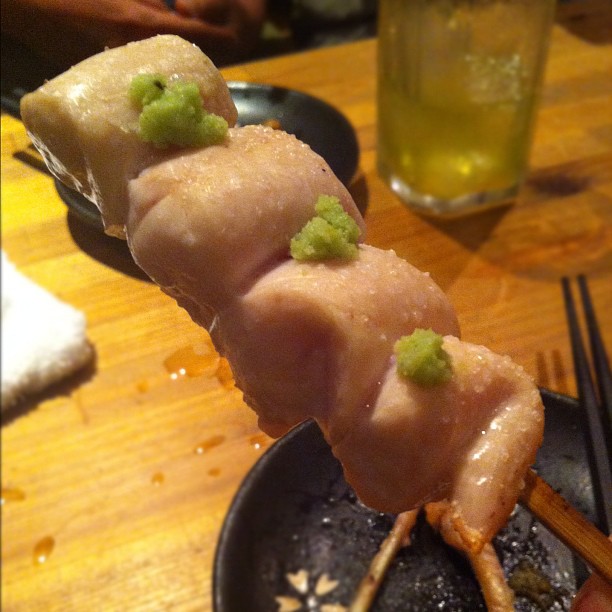
How to say it: sah-sah-me
How it’s written: ささみ
Momo*
Another recognizable part of the chicken, the chicken thigh is also perhaps one of the most delicious. Soft, tasty and even more delicious when grilled over charcoal.
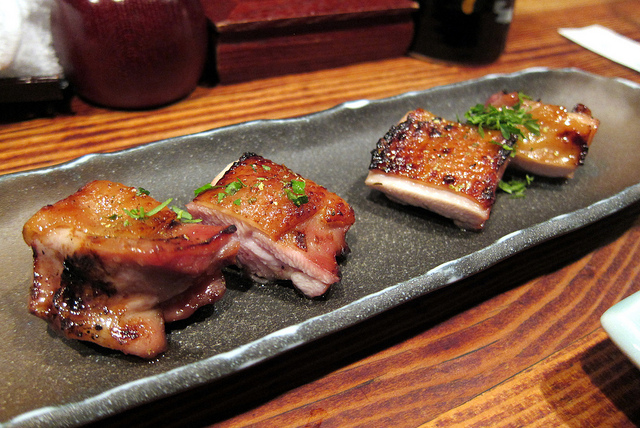
How to say it: moh-moh
How it’s written: もも
Negima / Tori-negima*
Different places do negima differently, with some using breast meat and others thigh, but whatever the cut, it will also come with grilled ‘negi’, a large Japanese spring onion. Most yakitori-yas will just call this ‘negima’, but you may see some call it ‘tori-negima’ (chicken negima) to differentiate it from ‘buta’ (pork) negima.
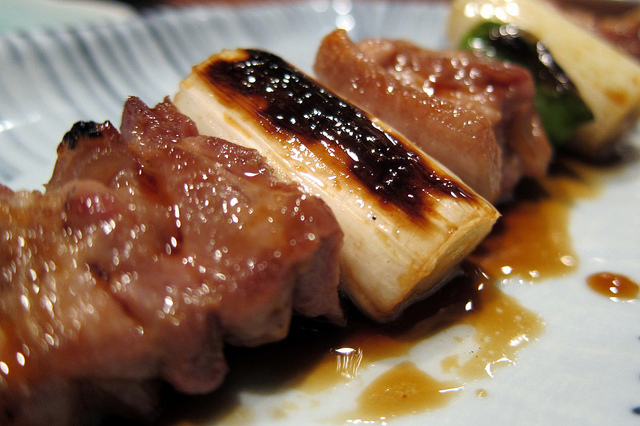
How to say it: Neh-gi-mah / Toh-ree-neh-gi-mah
How it’s written: ねぎま / 鳥ねぎま
Seseri
Being a fatty cut of the chicken, the neck is generally plump, with a real ‘umami’ taste. Delicious with a pinch of salt, it’s likely to see juice running down your chin.
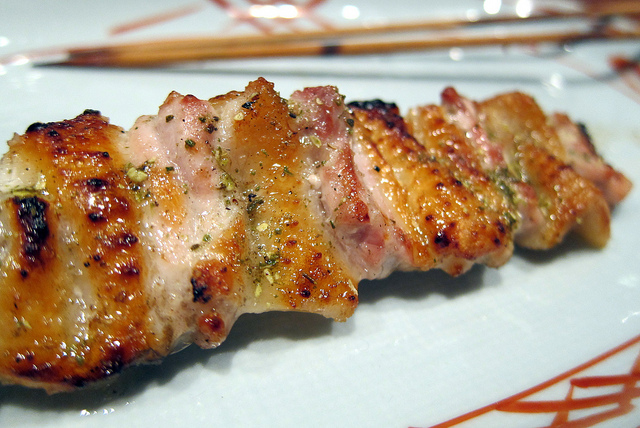
How to say it: seh-seh-ree
How it’s written: せせり
Sunagimo
Also sometimes called ‘zuri’ (ずり), sunagimo is the chicken’s gizzard. While that doesn’t necessarily sound too appetizing, sunagimo is surprisingly tasty, with a thick, crunchy texture. Especially good is hasami (はさみ) which is sunagimo in the style of negima.
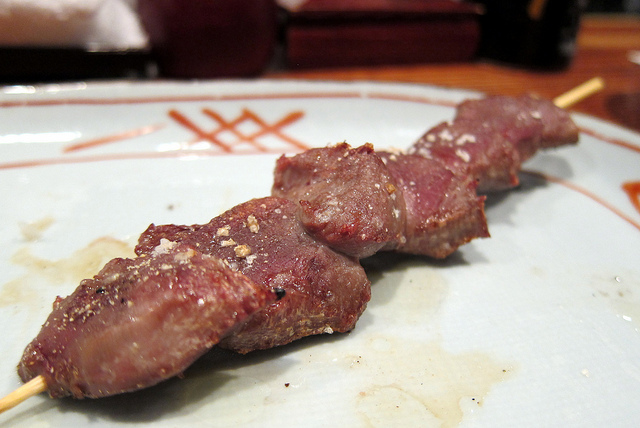
How to say it: soo-nah-gi-moh
How it’s written: 砂肝
Tsukune*
Perhaps best described as chicken meatballs on sticks, tsukune is a standard staple of the yakitori-ya. However, some places do it better than others, and at worst it can be a bit bland and preformed. But when done correctly, especially made by hand and stuffed with shiso leaves, it will be the best dish on the menu.
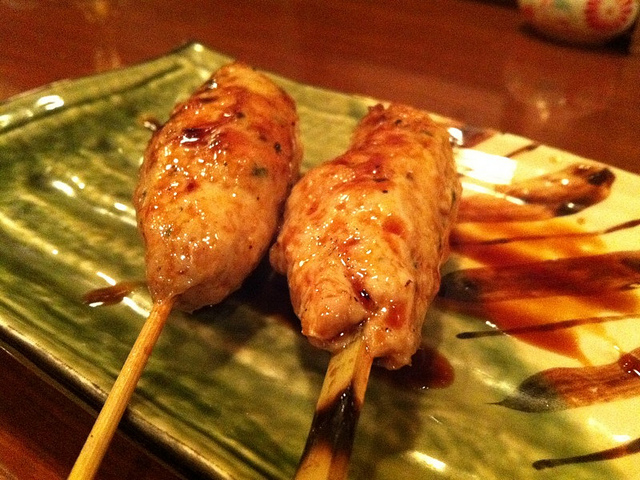
How to say it: ts-koo-nay
How it’s written: つくね
Kawa / Torikawa
Another yakitori choice that seems a little off-the-wall, but makes perfect sense when you think about it. When grilled until crispy with a pinch (or a liberal helping) of salt, the chicken skin can be the best bit of the bird.
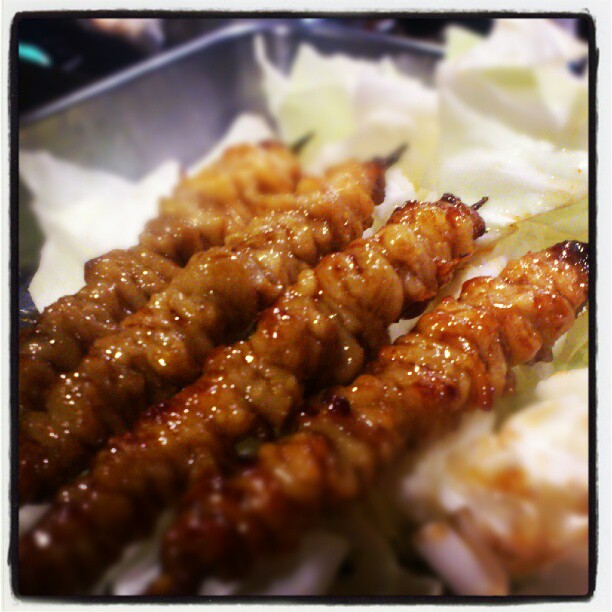
How to say it: ka-wah / toh-ree-ka-wah
How it’s written: かわ / とりかわ / 鳥かわ
Nankotsu
Nankotsu is perfect for those who like a bit of texture in their meal. Something of an acquired taste, the cartilage is the crunchiest bit of the bird (bones aside, of course), and is perhaps at its best when deep fried in the karaage style (唐揚げなんこつ).
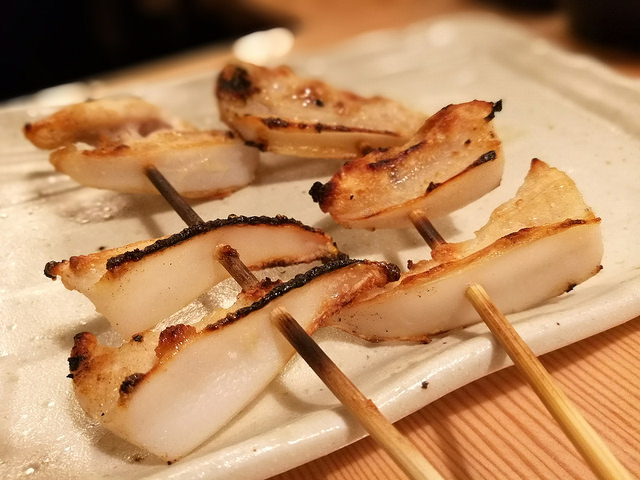
How to say it: Nan-koh-tsoo
How it’s written: なんこつ
Hāto / hatsu / kokoro*
Another one for the more adventurous amongst you, the chicken heart is smaller and crunchier than you would expect and has a really meaty flavor. As its texture succeeds or fails on the chef’s abilities, it is perhaps one best to try at a more upmarket yakitori-ya.

How to say it: haah-toe / hah-tsoo / koh-koh-roe
How it’s written: ハート / ハツ / こころ
Rebā*
The thought of eating liver probably jolts the inner-child in you with horrible memories, but clear them from your mind. Chicken liver is surprisingly soft and fluffy, with a fantastic umami taste. Though it is another one that relies on a good chef, should you see deep fried liver on the menu (レバーフライ) it should be your first choice.
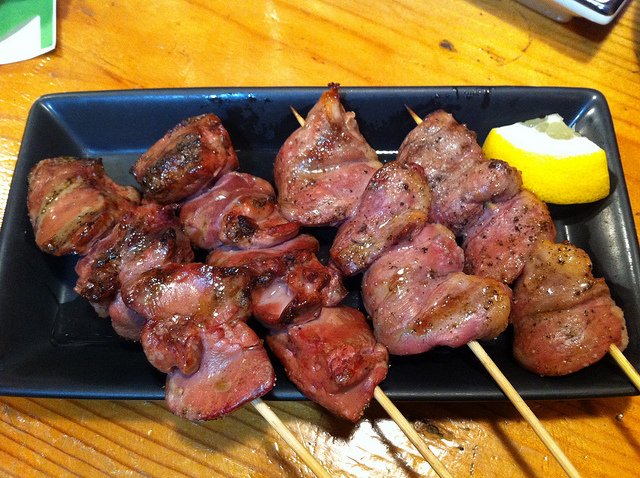
How to say it: reh-baah
How it’s written: レバー
Seasoning
When you make your order, the waiter/chef will most likely ask which kind of seasoning you would like. As a rule, there are two kinds: salt (塩 she-oh) or tare (たれ tah-ray). The former is self-explanatory, but the latter is a salty-sweet sauce generally made up from mirin, sake, soy sauce, and sugar. While there is no incorrect way to enjoy your yakitori, I have included my personal preferences by placing an asterisk beside those with which I prefer tare.
However, if you are still unsure, you can ask your server to make a recommendation (おすすめ oh-soo-soo-may), and some places may have their own special concoctions. If you like a bit of a kick with your meat, why not sprinkle on some spicy shichimi pepper?
Mark Guthrie
Image: by Ishikawa Ken via flickr.com [CC BY-SA 2.0]
Image: by Wally Gobetz via flickr.com [CC BY-SA 2.0]
Image: by Wally Gobetz via flickr.com [CC BY-SA 2.0]
Image: by Wally Gobetz via flickr.com [CC BY-SA 2.0]
Image: by Wally Gobetz via flickr.com [CC BY-SA 2.0]
Image: by くーさん via flickr.com [CC BY-SA 2.0]
Image: by Ayane Sakidsuki via flickr.com [CC BY-SA 2.0]
Image: by Masahiko OHKUBO via flickr.com [CC BY-SA 2.0]
Image: by cozymax via flickr.com [CC BY-SA 2.0]
Image: by Koji Horaguchi via flickr.com [CC BY-SA 2.0]
Feb 25, 2019
Partying Nagoya Style: Meieki’s best Izakayas
When it comes to going out for drinks, in Japan, they do things a little differently than back home. Whereas we would most likely head to a bar, the Japanese go to an izakaya.
Most translation tools will tell you that an izakaya is like a tavern or a pub, but that’s not quite right. While izakayas are very much drinking dens, particularly after work or at the start of a night out, unlike pubs there will be little or no interaction between separate parties. Also unlike pubs, all groups are seated and are served by waiters and waitresses at whom you must holler ‘sumimaseeeeen!’ to get their attention. That’s not to say things are any more sedate than bars back home. When the beer and highballs get flowing, things can get raucous, particularly as many izakaya offer ‘nomihoudai’ (all you can drink) courses.
While drinking is generally very much on the agenda, izakayas are also places to eat, with patrons sharing dishes between them. While differing establishments may have their specialties, and some are more upmarket than others, the general description of the fare on offer could be “for the accompaniment of booze”. Think, karaage, edamame, sashimi, and yakitori. Fine dining this is not.
As both a central business hub and home to one of the country’s largest train stations, the Meieki (literally translated as ‘Nagoya Station’) area has many izakayas to choose from, each servicing their niche. Below is a small selection that you might try.
Kabuto
All around Nagoya, perhaps related to the city’s military history, you can find an izakaya called ‘Kabuto’ (helmet). Some are connected, some aren’t, but this one is the best one. The food is a mix up of standard izakaya fare, with yakitori, sashimi, and nabe hot pots. But they also have some quite interesting stuff such as horse meat and ‘raw’ chicken.
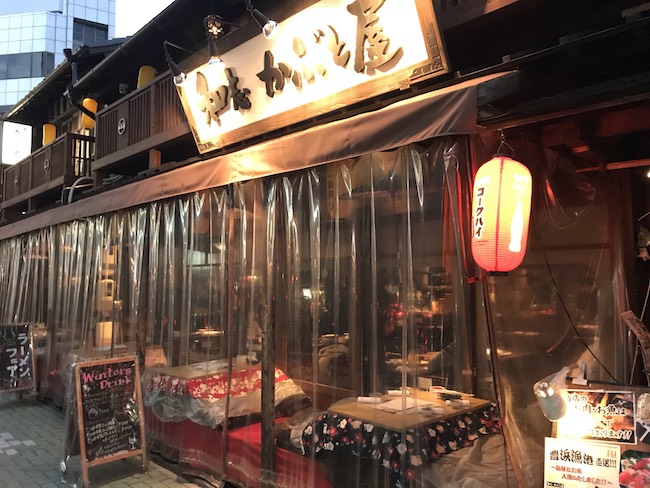
The best thing about Kabuto is that it has some tables that hang out into the street, which is excellent for people watching, especially in winter as the tables double up as a kotatsu. They also have English language menus, which makes things a little easier.
Where: 3 Chome-17-25 Meieki, Nakamura-ku (map)
Website: kobekangroup.com/shop/kabtoya
Gomitori
Established in 1956, the Sakae branch of Gomitori is credited as being Nagoya’s oldest-running izakaya, and is famed for its classic Nagoya cuisine. There are two Gomitoris in the Meieki area, and while the newer one is closer to the station, it cannot rival the older one for atmosphere, as its dark dinginess creates are real drinking den vibe.
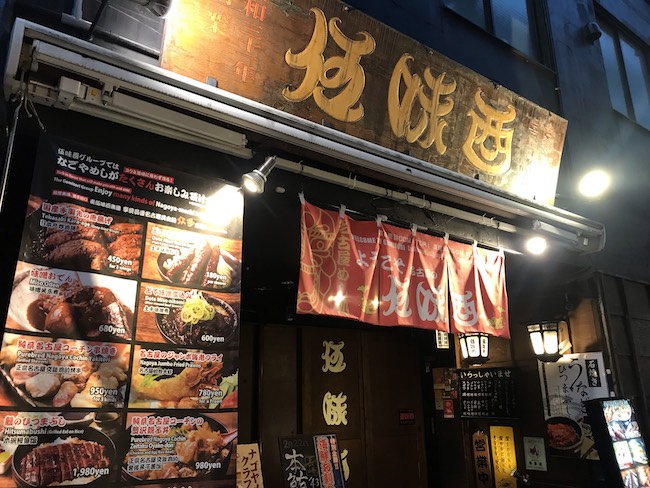
While neither of these is the original, they do still serve up the same Nagoyan food, and they do it well. Most recommended are the famous dote miso stew, the dote miso pork cutlet skewers (miso kushi katsu), and tebasaki chicken wings made with Nagoya’s prized kochin chicken.
Where: 3 Chome-18-6 Meieki, Nakamura-ku, Nagoya (map)
Website: r.gnavi.co.jp/n002806 (Third Party Website)
Hanbey
Imagine a world where the Showa era never stopped, and pre-bubble-period kitch remained forever, and you have Hakuri Tabai Hanbey, or just ‘Hanbey’ for short. The walls and every available surface are adorned with movie posters, advertisements and toys from that bygone era, and overhead enka music blares away; all making for an original, if a little discombobulating, drinking atmosphere.
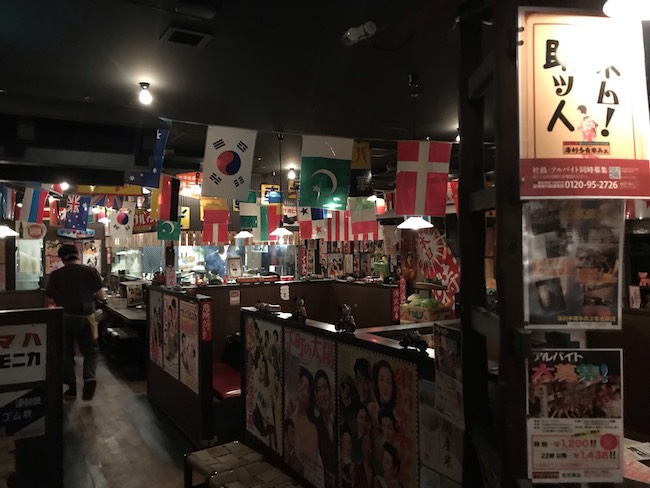
It is also very cheap, with a large jockey of beer for around 290 JPY, and some food items for under 100 JPY. The food itself is, well, not exactly excellent, but if you are just up for a lively place with a difference, then Hanbey is a good shout. They also have an English language menu with translations so laughingly bad that they have to be done so on purpose.
Where: 3 Chome-15-8 4F, Meieki, Nakamura-ku (map)
Website: hanbey.com
Pichiten
Using the freshest seafood from the nearby Yanagibashi Market, Uogashi Hompo Pichiten is well known for its delicious sushi and sashimi. But as well as being extremely fresh, the food is very reasonably priced, and they do selection plates, which makes things easier for those who don’t know what they want (or even looking for!) As well as seafood, Pitchiten does a huge tempura selection that is not to be missed: if you can fry it, they will serve it!
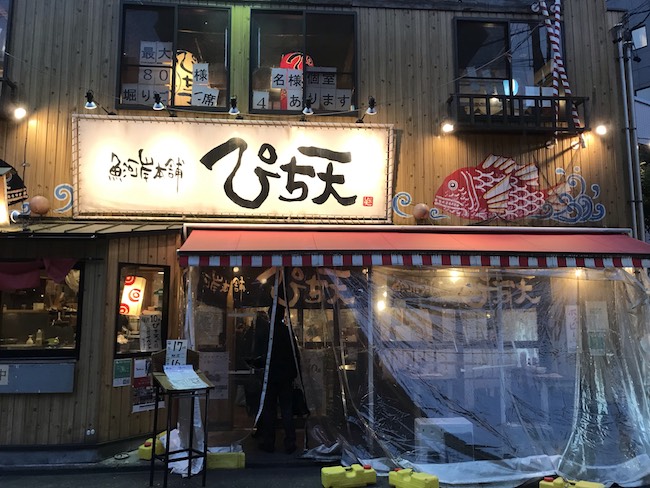
There are a handful of Pitchitens around the city, and the one pictured above is nearest Meieki (a stone’s throw from Lucent Tower) However, though a little bit of a trek from the station, this one here has a sort of beer garden upstairs, which is great for dining during the warmer months.
Where: 2 Chome-36-17 Meieki, Nakamura-ku (map)
Website: pichiten.com
This is just a small selection of the many, many izakayas that you can choose from in the Meieki area. If you want to find something different, one great way is to speak to one of the ‘misenavi‘ guys. These are young men and women – students, mostly – for whom their job is to connect diners with restaurants. You will see them outside of the Dai Nagoya Building and the surrounding areas wearing bright red or orange jackets. Just tell them what kind of thing you want (whether it be seafood, cheap drinks, all you can eat or drink nomihoudai and tabehoudai options) and they will do their best to connect you. Oh, and they get their commission from the restaurants, so you don’t need to pay them.
Mark Guthrie
Image: by Hideya HAMANO via flickr.com [CC BY-NC-ND 2.0]
Images: by Mark Guthrie (Own Work)
Feb 25, 2019
Aqua Net Ferry from Peace Park to Miyajima
Two of the best things about Hiroshima are its rivers and its proximity to the UNESCO World Heritage Miyajima. Unfortunately, many visitors to the city take no more than a passing, sidelong glance at the rivers, and board crowded trains to the JR Miyajimaguchi station to take one of the large ferries across to Miyajima.
Don’t do that. Instead, wander over to Peace Park early in the morning, and get your fill of the place. The Peace Memorial Museum opens its doors at 8:30 in the morning. Even if you linger, and you should, you can be finished by 10:30. Look at the rest of the park, then head for the Aqua Net ferry pier, just south of bridge below the A-Bomb Dome.
The Aqua Net is a great way to get to and from Miyajima, immensely more pleasant than the train and car-ferry route that many people take. Because Hiroshima’s rivers are tidal, services are suspended when the water is either too high for the boats to pass beneath bridges or too low for safe navigation over sandbars and other obstacles. According to their website, this is most frequently the case in spring. Check the website’s timetable on the day you want to travel. Fortunately, the website is informative and easy to navigate, with English that’s just flawed enough to be charming.
But if the boats are running, this is the way to go. You can stand outside on the deck as the boat travels down the river toward the Seto Inland Sea, waving to dog-walkers and picnickers along the banks. As you enter the sea, you’ll want to go inside the cabin, where windows on all sides guarantee excellent views, near water level, of the sea, shore and islands as you’re whisked to Miyajima in 45 minutes. It makes for an enjoyable trip even before you arrive at the main attraction, which can’t honestly be said for any of the alternatives. And with boats leaving about every half hour from 8:30 in the morning, with the last return boat from the island at 17:30, it can’t be beaten for convenience and ease of travel. Yes, it’s more expensive than JR. And it’s worth it.
Aqua Net also runs a “Miyajima Light-Up Cruise” from their pier on the island. These cruises begin after Aqua Net’s last ferry has returned to Peace Park, but if you’re planning to stay on the island after dark, the 30 minute cruise aboard the Daisan Mikasamaru is a good way to get a close up look at Itsukushima Shrine’s famous Torii gate from the water, with both the Torii and Shrine beautifully illuminated. Make sure you get your reservations in at least two hours ahead of departure. The cruises typically start at 17:55, but for much of the year you’ll want to go later. The illuminations are automated and begin when sensors register that daylight has fallen below a certain level. If you’re going to buy a ticket, you might as well get the full effect.
Aqua Net Ferry from Peace Park
Access: Hiroshima Peace Memorial Park. The ticket office and pier are down a set of stone steps from the cafe south of the A-Bomb Dome.
Hours: Departures from 8:30 to 17:10. Last return ferry from Miyajima departs at 17:30. The trip takes around 45 minutes.
Telephone: None listed.
Tickets: One-way, Adults (12 and over) 2000 JPY, children 6-11 700 JPY, one child under 6 per adult, free. Round trip, Adults (12 and over) 3600 JPY, children 6-11 1800 JPY, one child under 6 per adult, free.
Additional Info: Service may be canceled or restricted according to tidal and weather conditions. Please check the website for the day you want to travel.
Website: http://www.aqua-net-h.co.jp/en/heritage/
Photo by author
Feb 23, 2019
TeamLab’s Digitized Hiroshima Castle
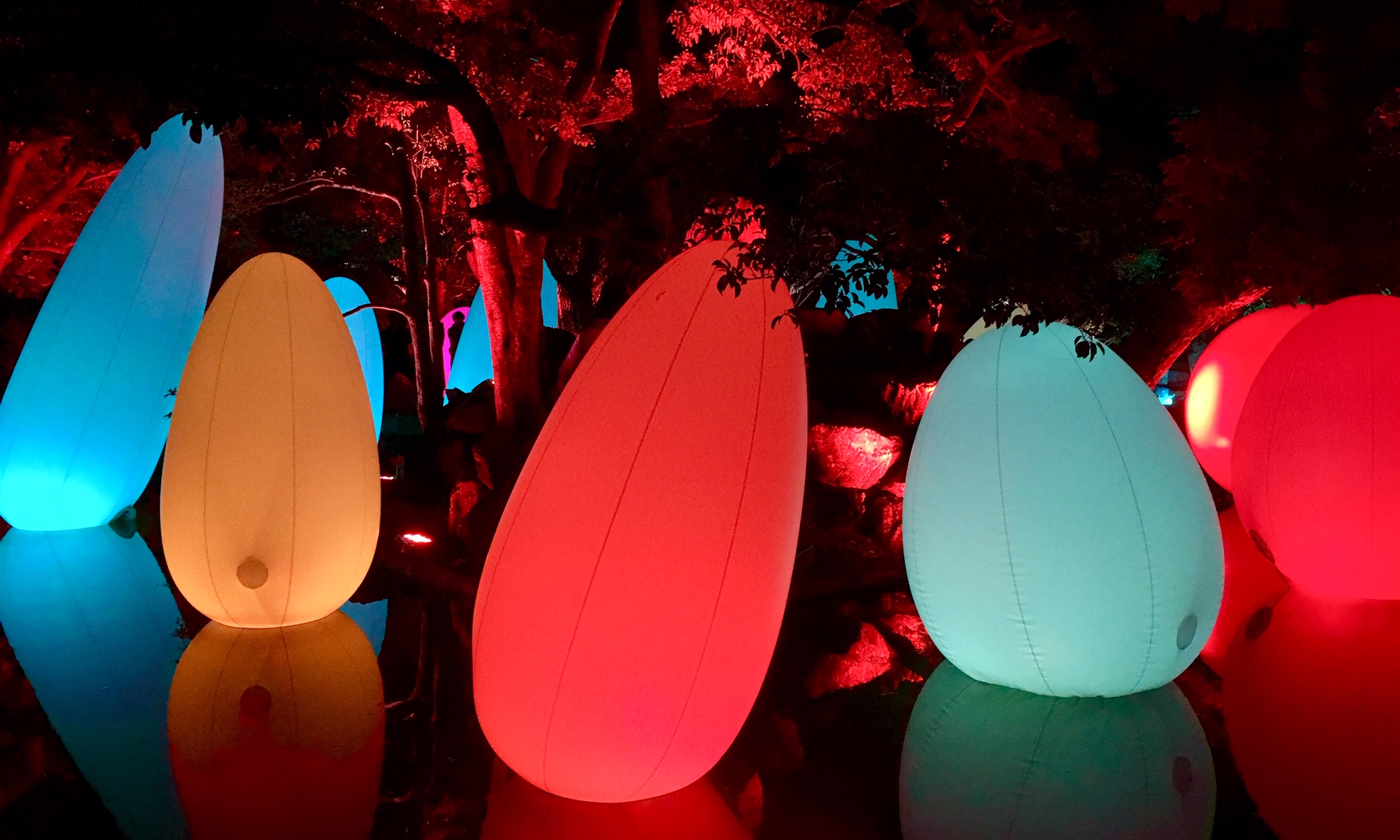
teamLab (and yes, that’s the way it’s capitalized) is an artist’s collective based in Tokyo that bills itself as taking an “ultra-technological” approach to its work. The group was founded in 2001 by Toshiyuki Inoko, a University of Tokyo engineering student. Today the group has grown to over 400 members, and after a string of successes abroad has been winning increasingly large audiences at home in Japan.
In interviews, Inoko has spoken about his early frustration with the “borders” imposed by photography, which was the first medium he took up. Looking at photographs he’d taken of wooded landscapes, they never recreated for him the feeling he’d had playing in the woods near his childhood home in Tokushima. He decided to pursue art without boundaries, that allowed audiences to enter and engage with the pieces. It is also essential to teamLab that their works not permanently alter the places where they are shown. They are temporary, interactive enhancements of a place; not material impositions.
This approach is beautifully on display right now on the grounds of Hiroshima Castle. A nocturnal dreamscape of large, egglike structures (teamLab uses the term “ovoids”, but my eight-year-old immediately identified them as eggs, and you will too) has taken over space within the 430-year-old walls of the castle. Visitors are encouraged to push or tap them, as unearthly, hypnotic music fills the air. When touched, they change color and may also cause nearby ovoids to change color as well, or set up a slow pattern of color changes spreading outward. According to the materials, the advance of a wave of color gives away the presence of other visitors in the area, but on the crowded evening that I stopped by, this effect was undone somewhat by the fact that scarcely an ovoid in the place wasn’t being slapped, prodded or headbutted by gleeful visitors. Despite the crowds (and this was a Saturday night early in the exhibit, so don’t be scared away) the atmosphere was enchanting. In some places, the ovoids are nearly four meters tall and clustered so thickly together that moving through them is like walking through a wobbling, rocking maze. The castle itself is illuminated as well, the colors shifting as feedback is received from the ovoids. And at the rear of the castle, calligraphic shapes and carp float eerily across an ancient stone wall stretching along the moat.
teamLab writes that “the concept behind the project is that non-material digital technology can turn a city into art without physically altering it.” And I’d say they’ve succeeded. People loved it. Old couples moved slowly along the paths, smiling at small children who could scarcely believe their eyes. It’s on until April 7, 2019 and worth a visit.
TeamLab’s Digitized Hiroshima Castle
Access: Hiroshima Castle Grounds, downtown Hiroshima, north of Sogo and Pacela. Entrance is through the east gate, next to the RCC Radio building.
Hours: 16:30-21:30 (last entry at 21:00), until Sunday, April 7.
Admission: Adults (16 and over) 1000 JPY, Elementary/Jr. High 700 JPY, children 6 and under admitted free
Additional Info: If you enter the space during daylight hours, it’s free, but this is meant to be seen at night.
Website: https://www.teamlab.art/e/hiroshima
Photo by author, Matt Mangham
